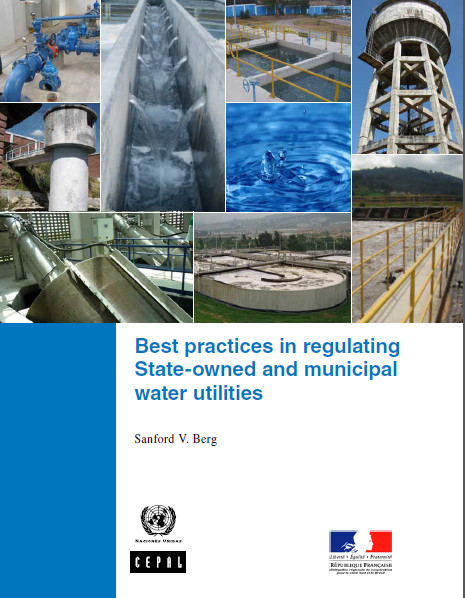Best practices in regulating State-owned and municipal water utilities
 |
Boas práticas de regulação dos prestadores públicos de serviços de água e esgoto
rapport coll. Documents de Projet n° 542 May 2013 ; 66 pages
Aut. Sanford Berg
Ed. CEPAL - Santiago de Chile
Téléchargeable sous format: PdF
Téléchargeable chez l'éditeur
Page de présentation d'un éditeur
Abstract:
The fundamental lesson that emerges from this survey of regulating state-owned and municipal water utilities in developing countries is that sector regulation has to be embedded in an adequate and consistent institutional framework in order to have a positive impact on performance. Sector regulation, by itself, is no guarantee of performance improvements in the drinking water supply and sanitation sector. Case studies and empirical analyses suggest that without significant changes in the supporting institutions, the standard tools of regulation will not be effective. This conclusion is disturbing, especially for developing countries, since it means that the establishment of a regulatory agency might raise hopes, but ultimately, the agency’s rules are unlikely to improve performance without additional, politically difficult initiatives. An industry observer said "to have effective regulation, you must have utilities that can, in fact, be regulated". The problem boils down to getting a broader set of institutions to support regulatory and managerial actions that promote good sector performance. This means getting the governance structures right (rules of the game) and the substantive actions right (play of the game). Conflicts usually arise in the politically-sensitive water services sector, so the regulator also needs to develop tools for conflict resolution. Thus, the conclusion that the institutional environment matters also provides a rationale for establishing a comprehensive set of governance reforms. These reforms may go beyond the jurisdiction or immediate responsibility of the regulatory agency itself. Nevertheless, an autonomous regulator can (in many cases) facilitate reforms that lead to lower costs, improved service quality, and greater network coverage. On the other hand, when both operations and oversight are part of the same organization (whether a ministry or municipality), pressure for strong performance is unlikely since reforms represent a public admission that past procedures were inadequate (at best) or corrupt (at worst). This study identifies best practice in regulatory governance and corporate governance of state-owned and municipal utilities. The regulatory system goes beyond the regulatory agency and the water utility to include stakeholders that are in a position to support, block, or blunt reforms that would improve performance. In particular, this study documents how domestic politics can limit the effectiveness of regulatory institutions. Greater transparency (for example, via benchmarking and accountability) and citizen participation (via public hearings, public consultation processes, workshops, and consumer advisory boards) represent two ways the regulator can gain leverage against those benefiting from current dysfunctional arrangements. Without broad institutional support, even a technically competent regulatory commission will find itself marginalized by political forces that are far stronger. If the local "regulator" is the municipal commission, lack of professional skills and political cronyism usually exacerbate the problem. Ultimately, a sound regulatory system requires coherence, creativity, real-time communication, collaboration, consultation, and credibility. Resumo:
A lição fundamental que emerge deste estudo sobre a regulação dos prestadores de serviços públicos de água e esgoto de propriedade pública nos países em desenvolvimento é que a regulação do setor deve ser incorporada em um marco institucional adequado e consistente, para ter um impacto positivo sobre o desempenho. A regulação do setor, por si só, não é garantia de melhorias de desempenho nos serviços de abastecimento de água e de esgotamento sanitário. Os estudos de caso e as análises empíricas sugerem que, sem mudanças significativas no ambiente institucional, as ferramentas típicas de regulação não serão eficazes. Esta conclusão é preocupante, especialmente para os países em desenvolvimento, uma vez que significa que a criação de uma agência reguladora pode elevar expectativas, mas, em última instância, as regras da agência podem não ser de melhorar o desempenho do(s) prestador(es), sem que sejam tomadas iniciativas adicionais politicamente difíceis. Contents:
I. Introduction . 7
A. Standards for measuring performance . 7
B. The politics of water . 9
C. Institutional context for regulation . 12
D. Regulatory frameworks . 15
E. Indicators of weak performance . 16
F. Promoting transparency . 18
II. Regulatory governance and substance . 21
A. Regulatory governance . 21
1. Evaluating regulatory governance . 21
2. Regulatory governance and transparency . 23
B. Regulatory substance . 25
1. Regulatory instruments . 25
2. Regulatory processes revisited . 29
III. SOE utility governance and substance . 31
A. SOE utility governance . 31
1. Aligning incentives . 31
2. Elements promoting good governance . 33
B. SOE utility substance . 34
1. High performing utilities . 35
2. Capacity building . 35
IV. Best practice: benchmarking and conflict resolution . 37
A. Sources of conflict . 38
B. Regulatory governance for conflict resolution . 38
1. Research: What are the facts? . 39
2. Research and negotiation: How should benefits and costs be allocated? . 40
3. Adaptive work: What is important? . 42
4. Adaptive work: Who has jurisdiction? . 43
V. Key lessons and conclusions . 45
A. Key lessons for utility regulation . 45
B. Conclusions . 48
Mots clefs: |
bloc sanitaire public (CI) (DT) (OP) (ope) , mode de gestion/gouvernance (CI) (DT) (OP) (ope) |
Editeur/Diffuseur: |
|
CEPAL
-
Comisión Económica para América Latina - Santiago de Chile - Chili |
En cas de lien brisé, nous le mentionner à communication@pseau.org